

Eco-friendly fashion menswear brand STÓR reveals branding - Design Week Design Week. Consultancy Socio Design has created the branding for a new subscription menswear brand which is focused on environmental friendliness.
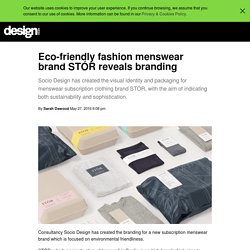
STÓR, which means “a store of treasure” in Gaelic, is an Irish brand which aims to combine a luxury fashion feel with recyclable and sustainable products. It sells men’s basic clothing, such as underwear, socks and t-shirts. Socio Design worked with an existing logotype to create the branding and packaging for STÓR, which aims to lend from the company’s ethos of eco-awareness. Clothes are made from natural materials such as organic cotton and bamboo. How Will Climate Change Affect What We Wear? Surprise! It Already Has. The nefarious effects of climate change can be felt everywhere, scientists say, from last year’s extra-balmy winter to last week’s Hurricane Sandy, a storm whose destructive brawn some attribute to global warming.

But flux in climate patterns is also manifesting in an unlikely place: our closets. Climate change, the term given to trends in statistical weather patterns, is often closely linked to anthropogenic global warming, and it’s likely a large reason that U.S. climates are getting warmer each year. Conscious Design Can Drive Change in the Fashion Industry. Read more in this series The fashion industry as a whole doesn’t have a great reputation.
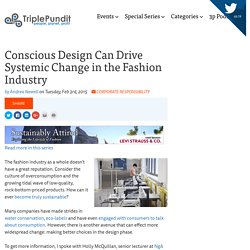
Consider the culture of overconsumption and the growing tidal wave of low-quality, rock-bottom-priced products. How can it ever become truly sustainable? Should luxury fashion brands be pursuing sustainable packaging? Eco-friendly fashion is enjoying a boom in demand, and luxury retailers often have more freedom and resources to explore the market than fast fashion brands.

We think that sustainable packaging has an important role to play in this market, and here’s why... Luxury brands that love sustainability Several luxury retailers are bringing in impressive environmental standards, but British designer Stella McCartney truly operates her fashion business with sustainability in mind, as she explained at the Financial Times Business of Luxury Summit in 2014. All Stella McCartney UK stores, offices and studios are powered by wind energy, and renewable energy sources are used elsewhere whenever possible.
Sustainability in the Fashion Industry - Supply Chains Effect on the Environment. As one of the biggest players in the global economy, the fashion industry has a responsibility to help protect the environment.
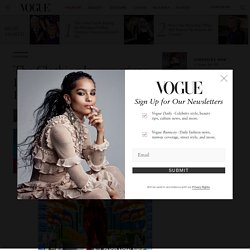
The Fashion Industry and Its Impact on the Environment and Society. Editor’s Note: This post is part of the on-going collaboration between S&S and GreenBuzz to promote increased dialogue between sustainability practitioners, academic experts, and the general public.
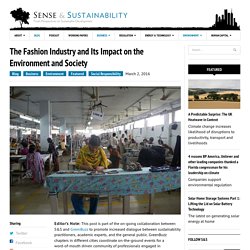
GreenBuzz chapters in different cities coordinate on-the-ground events for a word-of-mouth driven community of professionals engaged in sustainability, bringing sustainability leaders together to connect with each other and to discuss specific sustainability topics. Fast Fashion Is the Second Dirtiest Industry in the World, Next to Big Oil - EcoWatch. “The clothing industry is the second largest polluter in the world ... second only to oil,” the recipient of an environmental award told a stunned Manhattan audience earlier this year.
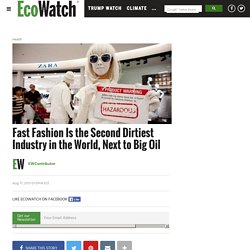
“It’s a really nasty business ... it’s a mess.” Since 2011, the Greenpeace Detox campaign has challenged some of the world's most popular clothing brands to eliminate all releases of hazardous chemicals. What Sustainability Means To The Millennial Generation. Jo Godden, Founder of RubyMoon, discusses how brands can limit their environmental impact worldwide According to Goldman Sachs, there are around 92 million millennials in the US currently, making them the largest demographic in American history so far.

Critically, they are also set to be the most important consumer group yet, with estimates of annual spending projected at around $200 billion by 2017, and $10 trillion over their lifetimes as consumers. With these figures comes the all-important question of how business can best cater to this multi-faceted millennial marketplace—the real questions being what do they value? And therefore, what do they want to spend their money on? The question points us back to sustainability. Recent studies indicate that millennials have a new, insistent consumer appetite that is colored distinctly green. However, the main problem facing these pioneering brands is gaining consumer exposure. Untangling ethical fashion. Floating city of the future could be built off Hong Kong coast. Floating City dreamed up by British and Asian designers showing what cities of the future could look likeWould feature farms, docks, canals, a hotel, entertainment complex and a huge floating stadium for sportsMetropolis made from hexagonal and triangular modules which attach with underground walkways and tunnels By Chris Pleasance Published: 10:12 GMT, 28 May 2014 | Updated: 12:05 GMT, 28 May 2014 The lost city of Atlantis may only be a legend, but if these designs are anything to go by then underwater towns could soon become a reality.

This incredible 'Floating City', which spans four square miles, comes with its own dock, roadways and farms to make it completely self-sufficient. Sustainable Style Meets Eco-Friendly Design At Atelier Akeef. Eco-conscious fashion is not a passing trend or a design fad that will blow away in a season or two.
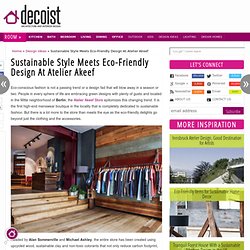
People in every sphere of life are embracing green designs with plenty of gusto and located in the Mitte neighborhood of Berlin, the Atelier Akeef Store epitomizes this changing trend.